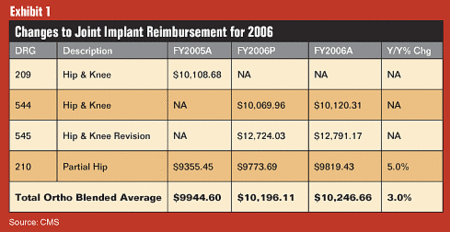Medicare implant compensation this year close to last year’s level
Overall reimbursements for joint replacement up about 3%, essentially in line with last year.
The Centers for Medicare and Medicaid Services has released final reimbursement codes for fiscal 2006 for inpatient hospital procedures; which account for most procedures reimbursable by Medicare. The announced rates are essentially in line with the proposed rates released in April and very similar to last year’s increases.
The codes took effect Oct. 1 (the beginning of the government’s fiscal year) and are particularly important to orthopedics because Medicare is believed to account for approximately 57% of reimbursement for joint replacement procedures. (This figure may be a bit misleading — we believe that private payers lately have been increasing reimbursement at near double digit rates, which has helped hospitals deal with the growing costs of orthopedic implants.)
New DRGs
CMS reclassified several Diagnostic-Related Groups (DRG) codes, which skews year-over-year comparisons. Specifically, it revised the codes under which major joint replacements for the hip and knee get reimbursed. Previously, these procedures were covered under DRG 209 — “major joint and limb reattachment procedures of lower extremity.” (For reference, in fiscal 2005, the DRG 209 reimbursement rate was up 2.7% over 2004 levels.)
This year, in response to a presentation by the American Academy of Orthopaedic Surgeons (AAOS), CMS set up DRG 544 (“major joint replacement and reattachment of lower extremity”) and DRG 545 (“revision of hip or knee replacement”). DRG 544 will be reimbursed at $10,120 and DRG 545 will be reimbursed at $12,791. We estimate that these new codes represent about a 2% increase over DRG 209. Finally, reimbursement for DRG 210 (“partial hip replacements”) was up 5% to $9,819, following a 3.8% increase in 2005. We estimate that the combined joint replacement DRGs will improve 3%, to $10,247.

Add-on payments: 0 for 4
Reimbursement related to Medtronic’s INFUSE and Stryker’s OP-1 and Trident products became a point of focus in this year’s final rule.
As expected, the new technology add-on payments for INFUSE and OP-1 when used for spinal fusion were discontinued. The reason: INFUSE had been on the market for three years as of July 2005, which is generally the length of time new technology add-on payments remain in effect.
In addition, Medtronic’s application for a new technology payment for the use of INFUSE to treat open tibia fractures was denied for the second time. CMS based its decision on its assessment that INFUSE is substantially similar to Stryker’s OP-1 putty. Lastly, Stryker applied for a new technology add-on payment for its Trident hip. The agency denied this request for the first time; however, this does not come as a complete surprise to us as we do not see this as a breakthrough technology.
Add-on expiration mutes gains
Spinal fusion procedures were also a critical focus this year. As illustrated in Exhibit 2, the reimbursement proposals for ex-cervical spinal fusion procedures (DRG 496, 497, 498) were healthy, with increases in the 7% to 9% range. Cervical fusion procedures (DRG 519, 520) also saw positive reimbursement growth in the 6% to 7% range. On a blended average basis, we estimate that spinal implant reimbursement will rise 7.1% to $15,317. We suspect most of this increase is to compensate for the expiration of the technology add-on payment for INFUSE. Hence, we think the total impact of the CMS payments will be slightly more onerous than the mid-single-digit increases we saw for 2005. (For reference, we estimate that INFUSE is used in about 25% of lumbar cases. This adds about $9,000 for a typical two-level lumbar fusion.)

Johnson & Johnson’s proposal for a new technology payment for Charité artificial total disc replacement (TDR) was denied by CMS as the agency believed that there was not sufficient evidence of substantial clinical superiority to spinal fusion. As a practical matter, the Charité is approved for use only in patients under age 60, which would suggest the number of Medicare patients receiving it would be quite small. But CMS’ decision to defer full reimbursement on the device until more data are accumulated is seen as a leading indicator by many private payers waiting on the sidelines with respect to coverage. CMS’s decision will likely cause private reimbursement and adoption to continue to move slowly.
For more information:
- Glenn Reicin and Matt Miksic are equity analysts covering the medical device industry at Morgan Stanley. Their insights into the orthopedics industry led the editors of Orthopedics Today to ask them to contribute articles from time to time. They have agreed to contribute (without compensation) in hope of eliciting feedback from the orthopedic community. You may contact them through Mr. Reicin at glenn.reicin@morganstanley.com.
